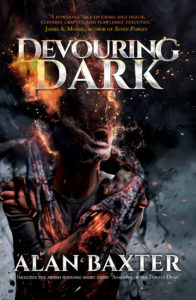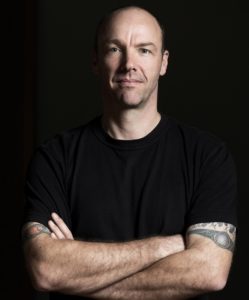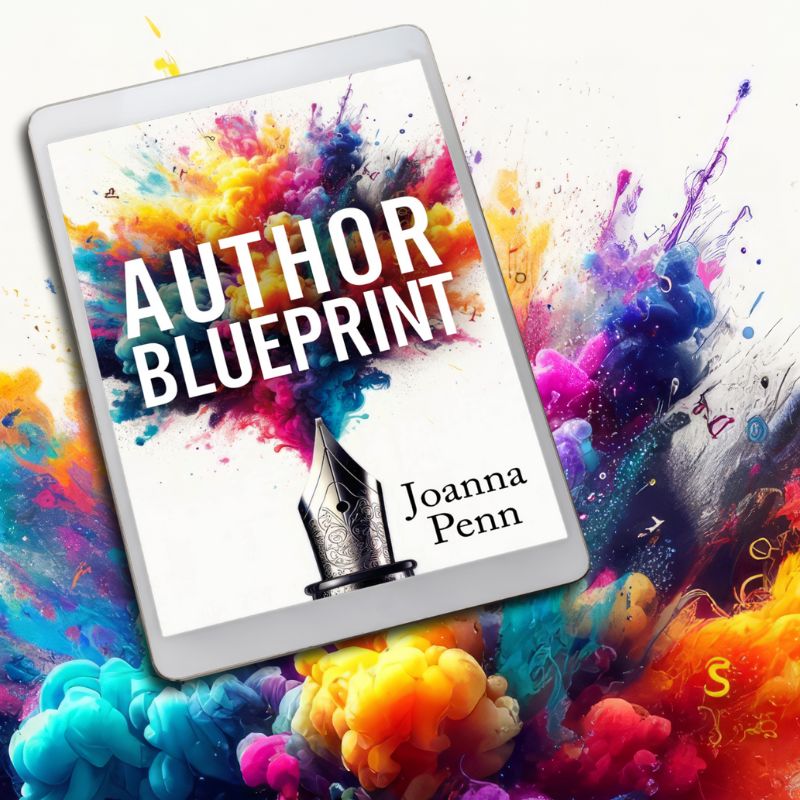The word horror encompasses a broad range of reader expectations and experiences – it is far more than just blood and guts.
For example, I love reading horror but I don't watch horror movies. I don't read gore-fest-style horror, but I love supernatural stories. My favorite authors include horror writers like Stephen King and Jonathan Maberry, and some of my own books flirt with horror tropes. I am a devotee of the genre!
In today's article, award-winning horror writer Alan Baxter gives some tips on how to write horror that emotionally connects with readers and stays true to the genre. Alan's latest book, Devouring Dark, is out now. You can also listen to a podcast interview with Alan about how to write short stories.
There’s a stigma to horror that needs to be addressed on a regular basis. In some ways it’s understandable, but it’s up to those of us who write horror to re-educate the reading public.
In the 80s and 90s, there was a horror boom in movies and paperbacks that ended up going in two directions. With books, there were some genuinely powerful horror stories, deep, literary, disturbing, original. There was also some sheer pulp, of course, but that’s normal in any genre.
With movies, there were slashers and gore. Sadly, it’s the movies that have stuck in the popular consciousness, which means that now, when I tell people I’m a horror writer, they immediately think of The Texas Chainsaw Massacre, Halloween, Friday the 13th, and any number of other blood-soaked movies where dozens of teenagers die horribly.
There’s a place for those movies (and their book equivalents) of course, but that’s not all horror is, or can be. I don’t write slasher horror, or torture porn, or splatter gore. But I do write horror.
I, like many others, write dark, disturbing, thought-provoking, frightening, unsettling stories and novels that interrogate what it is to be human.
So what are a few necessary considerations to keep in mind when writing good horror? Here are seven tips to get you started.
1. All story is character

Horror explores tragedy and misfortune, so our characters need to reflect that. Often, they’ll be in a horrible situation because of terrible decisions they’ve made, or desperate measures they’ve taken. Sometimes they’ll just be unlucky and stumble into terrible scenarios, but how they respond is important.
Everyone, good guys and bad guys alike, need strong, believable motivations, realistic flaws, genuine emotions. By playing with these we, as authors, can draw out the real meat of the story we’re telling. Character flaws and bad decisions are the bread and butter of horror fiction.
And, as a sub-point of this, setting is key. As far as I’m concerned, the setting is always a character in the stories I write, but I think it’s especially important in horror.
The landscape can change how a person responds to or is affected by the horror. Imagine Alien if they weren’t trapped on a spaceship, or Carrie if they weren’t in a high school with all the social interactions that occur there. Choosing where your story is set and who it’s happening to is essential groundwork.
2. You need more than one idea
A good story is built in layers. You might have an incredible idea for a monster, or a strange occurrence, or a weird infection – whatever the core idea of your story might be – but it doesn’t live in isolation.
Its strength, its horror, is amplified by other factors that exist around it. Your characters are more than simply victims or villains.
- What’s happening in their lives?
- Are they going through relationship breakdowns, trouble at work, health issues?
- Are they living their best life and are therefore completely unprepared for hardship?
The best stories are where something else is happening too, so that means understanding the greater lives of your characters and the world around them, and knowing life doesn’t stop just because something horrible is going down.
Horror is more frightening, after all, when it’s juxtaposed with everyone else’s normal life. A single candle both holds back and exposes the darkness.
A person might be dealing with a malevolent poltergeist at home, but they don’t want to lose their job too, so they have to go to work, right? Think about the greater picture around your story and build in the layers.
Good horror happens in real life, not in isolation.
3. Maintain tension
Once the two things above are in hand, the next most important aspect of horror is the maintenance of tension. Horror is suspense.
In movies and TV, this is most obviously exemplified in the jump scare – the music gets ominous, the character is sneaking through a dark house, or heading into the basement, and you know, you just know, that something is gonna get them, and then BANG! Jump scare. Or whoosh! No scare after all, leaving us feeling deflated and even more nervous next time the tension ratchets up.
Now it’s important that we don’t try to emulate that exactly in our writing, because something which works well in the medium of film often doesn’t translate into prose. But we do need to build tension and play with it in a similar way.
One of the best ways to build tension is through foreshadowing. We hint at things that lodge in our reader’s mind, then we draw those things out. We make the reader concerned about them, and we occasionally twang that thread of tension to put our reader on edge.
We can increase tension with ambiguous characters – who’s really good and who’s bad. Sometimes people can be both. Remember the points above about flawed characters and bad decisions.
Tension can also be consequences, the result of good or bad decisions going in ways the reader doesn’t expect, or can’t anticipate. Or the reader knowing a character has made a bad choice and just waiting for the inevitable fallout as the character goes merrily along, oblivious.
And talking of anticipation, be careful not to give everything away. We have to draw out the revelations. Staring the monster in the face is terror, not horror. Horror is knowing the monster is somewhere out there, in the dark, coming for you…
4. While maintaining tension, leave room to breathe
Some books play well with a constant state of anxiety, but a lot of the time that’ll just wear the reader out and they’ll stop reading for a rest instead. The danger then is that they don’t pick the book up again.
While it’s important to maintain suspense in a horror novel, you also need moments of calm, where the reader gets to take a breath even if the characters don’t. The best thing about this is that when you do ramp up the tension again, the reader has fallen into a false sense of security and gets extra impact from the return of the suspense.
And often the best use of tension is when someone has been kept taut for a long time, then they get a reprieve. There’s no better time than that to drop a bomb and shatter any sense of security.
5. Explore an underlying theme
This is a subtle thing, and you may not even realise what it is that you’re doing until you do it, but in the second draft and rewrites, figure out what your underlying theme is and make sure you’re drawing that up well.
It’s important not to be relentless with it, you don’t want to batter your reader with a message, but with all the crazy shenanigans that might be happening in your book, and the maelstrom of events your characters are going through, your guiding light should be your theme.
In my latest novel, Devouring Dark, I’m playing with themes of death, guilt, and redemption. Everything in the book is tailored around those ideas. Jack Ketchum’s terrible, amazing classic, The Girl Next Door, follows the themes of cruelty and lack of agency. Richard Matheson’s novel, I Am Legend, follows a theme of isolation and being different. (Don’t even talk to me about the awful movie of that with Will Smith!)
Regardless, you see my point. There should be a theme, or a couple of complementary themes, that underline your narrative, the invisible tracks that your horror train rides along.
This will not only keep you focused on the direction of your story, it’ll give greater depth to everything that happens, as it will all be framed by your themes, even if they are only subconsciously recognised by your readers.
In fact, it’s often better if they’re only subconsciously recognised, and only realised later if a person stops to analyse why they were so disturbed by the book.
6. Hit the head and the heart
Horror asks us questions, even if sometimes the question is as simple as, “Why the hell are you going into the dark basement? Run! RUN AWAY!”
So we need to make sure the reader is thinking, not just being fed everything. Show the creeping dread, hint at the unknowable infinity, ask what might lie in that undiscovered country beyond this mortal coil.
We need our reader invested in the characters and events, we need them to try to logically dissect the impossible, the uncanny, the contradictory. And while they’re busy thinking we stab them in the heart (and, for good measure, kick them in the guts.)
The heart and the gut are the emotion factories, the places we process all the hope and hopelessness, the love and anger, the tension and the fear. Engage your reader’s brain with questions, and gut-punch them with answers, or a lack of answers, or just more questions. Make them consider their fear of the darkness, then drag them into it.
7. Write what scares YOU!
I think it’s dangerous ground to try to anticipate what might disturb other people. Some people can pick up and pet a giant hairy spider, after all, whereas I’ll cut you if you try to get one anywhere near me.
We write the stories that only we can write, and we hope there are other people out there like us who will be entertained by them. It’s the same with the scares. We need to address things in our horror that disturb and unsettle us, and there will most definitely be other people out there who are scared of the same things.
One of my biggest fears in life is not being able to protect my son from the rigours of the world, so I know that a lot of my horror writing comes from that. I’m also a control freak, and I struggle when events are out of my control, so a lot of my writing addresses that too.
This kind of writing is cathartic for us, and will be for others like us who feel the same. And it will still appeal to people who don’t share those fears, as they’ll experience the authenticity of them through our characters as we’re writing from a place of understanding. Readers have empathy, and horror takes cruel advantage of that!
There’s obviously a lot more to writing than just these points – all the usual guidelines for good storytelling apply, and I could easily write another seven tips just for horror – but when it comes to crafting a good horror novel (or short story) the things above should help to point you in the right direction.
What are your favourite horror stories and why? By exploring the horror stories we love, we can further learn how to craft our own. Please leave your thoughts below and join the conversation.

If you want an idea of how he’s put the above into action, you can check out his collection, Crow Shine, which contains 19 horror and dark fantasy short stories, or pick up his latest novel, Devouring Dark, an urban horror novel set against a backdrop of crime and corruption in modern-day London. Feel free to hit him up online.
His website is warriorscribe.com and you can find him on Facebook, Twitter, and Instagram.


Great article, Alan! If you’re not already watching it, I recommend Eli Roth’s History of Horror on AMC.
I second everything you state here. I would also add that horror works best when it adheres to an internal logic, which means defining a set of parameters or rules. Horror writers used to do this excellently. Movies like Gremlins, Scream, and The Conjuring each set forth three inviolable “rules” that gave the narratives their suspense and meaning. Interview with the Vampire, The Sixth Sense, and Wolf all established consistent rules for their respective supernatural conceits. The rules that governed Buffy and Angel’s romance were what made it so tragic and heartbreaking. Hell, The X-Files was a procedural investigation to understand and rationalize the rules that governed the monster-of-the-week!
Too many horror writers nowadays, though, lack discipline, hence the spate of indulgent, orgiastic, “kitchen-sink” horror offerings like Penny Dreadful and American Horror Story, which are all style and no substance. And because “anything goes” in these worlds, there’s no suspense or meaning — all you get is an exercise in atmospherics. So I think horror authors would be well advised to consider and impose limits on what can happen in their supernatural fiction.
Yep, I agree. It’s true for all fiction, but especially all branches of speculative fiction (horror, fantasy, and SF). Internal consistency is essential.
Yes to all points.
“believable motivations,” – that is often violated in horror films. There is some noise from the cellar – so one person is going to explore it … yeah, right ..
There is a monster standing in front of me – I flee upstairs so it can block my way out – or I flee down into the catacombs – yeah, sure …
This trope is so clichée and still used in horror movies. That is the part where all claims to “believable” goes out of the window.
But motivations, comprehensible motivations, are needed for every story. And here they are again my three problems …
Ms. Penn – I enjoy your thoughts on all things writing.
One critique about this website design.
It has gray letters on a white background.
I recommend solid black letters on a white background.
It’s hard to read for those of us with lousy eyeballs.
Anyway, keep up the great work. I enjoyed this article!
I don’t know if this is asking too much but I would like you to teach me how to write.
I have alot of ideas and I have done my fair share of research I just seem to lack something.
I would really appreciate if you could teach me, maybe over Facebook or something..
Am John and am 18 from Nigeria
Hope you can help.
This is super great, I will love to see my self putting theses tips to paper and making my imaginary horror stories feel real…